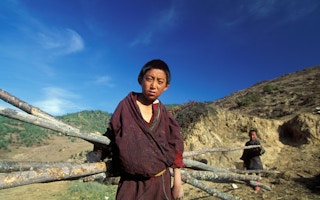In the Indonesian part of the island of Borneo, the indigenous community of Sungai Utik has been protecting 10,000 hectares of land for decades, defending their forests from industry and obtaining hard-fought land rights from the government.
Activists call it an inspiring example of a victory for indigenous rights - but in many places, local communities are struggling to protect vital biodiversity. Indigenous groups worldwide face growing threats from loggers, miners and other private interests as well as the impacts of climate change.
More international donor funding is being pledged to support them - but this cash usually comes with tight restrictions on how it must be used.
New research by two non-profits suggests that only a small fraction of funding for conservation efforts by indigenous and local group has been reaching the frontline.
The Sungai Utik people demonstrate what can be done when donors give ‘unrestricted’ funds to local communities to do things their own way, said Rukka Sombolinggi, secretary general of the Indigenous Peoples Alliance of the Archipelago (AMAN).
“
If we mobilise more money, what needs to change to ensure that it gets to the people who need it most on the ground?
Bryson Ogden, director of rights and livelihoods, Rights and Resources Initiative
The community manages its territory according to its own laws, reserving nearly two-thirds as protected forest and cultivating crops on the remaining land in a traditional rotation system that provides their food, water and medicine.
“That’s because they have a very strong leadership and governance system (and) they have their own indigenous law that they follow as a community,” said Sombolinggi, whose alliance helps indigenous communities raise funds and map their territories.
Major global donors are increasingly funding for nature protection efforts by indigenous peoples and local communities, with studies showing the role they play is key to effectively managing biodiversity areas and forests that act as natural carbon sinks.
Better protecting tropical forests - home to indigenous communities in the Amazon Basin and Southeast Asia, among others - is seen as crucial to tackling both climate change and cutting accelerating biodiversity losses.
At the COP26 UN climate conference in Glasgow last year, five governments and several foundations pledged $1.7 billion to help indigenous peoples and local communities advance their land rights and forest management by 2025.
But research released this week by the Rainforest Foundation Norway (RFN) and the Rights and Resources Initiative (RRI) said that just 17 per cent of about $2.7 billion invested by donors between 2011 and 2020 on these issues went towards activities that specifically named an indigenous peoples’ organisation.
The report said it indicated that a low share of funding is under the leadership of indigenous and community organisations.
“If we mobilise more (money), what needs to change to ensure that it gets to the people who need it most on the ground?” said Bryson Ogden, director of rights and livelihoods at RRI.
Ogden said a fundamental issue is that the donor community’s funding systems are designed for working with western non-profits, not indigenous and local communities.
Donor processes includes requiring levels of paperwork that are difficult for communities to manage and providing funding that is often too short-term or that involves lengthy application processes, according to the research.
Ogden said there were important lessons to be learned from the coronavirus pandemic, when donors including the Norwegian Agency for Development Cooperation (Norad) and the Ford Foundation made their funding more flexible.
This allowed communities to reallocate funds to respond more effectively to emerging and unforeseen threats to indigenous land, he added.
Ready to collaborate
In Indonesia, Sombolinggi said more needs to be done to reduce the “gap of reality” between donors and communities, pointing out that many indigenous people cannot read, write or even speak Indonesian.
She said there is a lack of transparency about where money is going, and too much cash gets “stopped in the middle”, spent by actors such as international consultants.
The report from RFN and RRI said a lack of accountability and transparency from both donors and recipients has been a problem, although there has been a concerted effort to improve this by international donors.
Sombolinggi said AMAN is the first indigenous organisation to publish regular financial statements and an annual audit of its projects.
Indigenous communities have a right to know where the money goes, she added.
To address the lack of funding reaching the ground, new mechanisms have been created such as the Community Land Rights and Conservation Finance Initiative (CLARIFI), which is testing systems to channel donor funds directly to communities in the Congo Basin and tropical Andes.
In Brazil, the Podáali Fund similarly works to allocate resources directly to indigenous communities across the Amazon rainforest.
In a press conference, the Podáali Fund’s deputy director Rose Meire said she understood regulations and processes are necessary, especially as funding comes from foreign governments, but said they have become “excessive”.
At Egypt’s COP27 UN climate talks in November, Meire said she expects donors to work with indigenous communities to create a process to provide more direct funding.
“We are ready to create alliances,” she said. “We are not going to stop our fight.”
This story was published with permission from Thomson Reuters Foundation, the charitable arm of Thomson Reuters, that covers humanitarian news, climate change, resilience, women’s rights, trafficking and property rights. Visit http://news.trust.org/climate.










